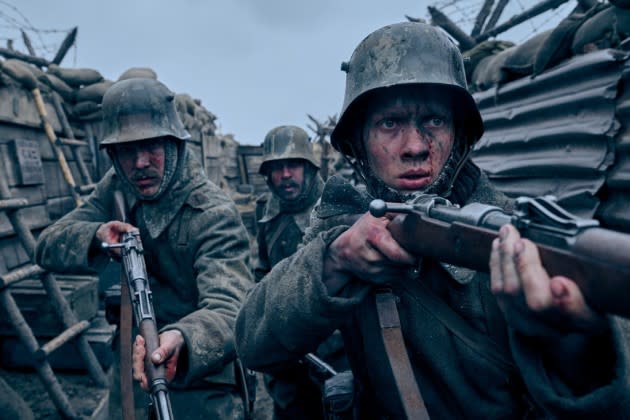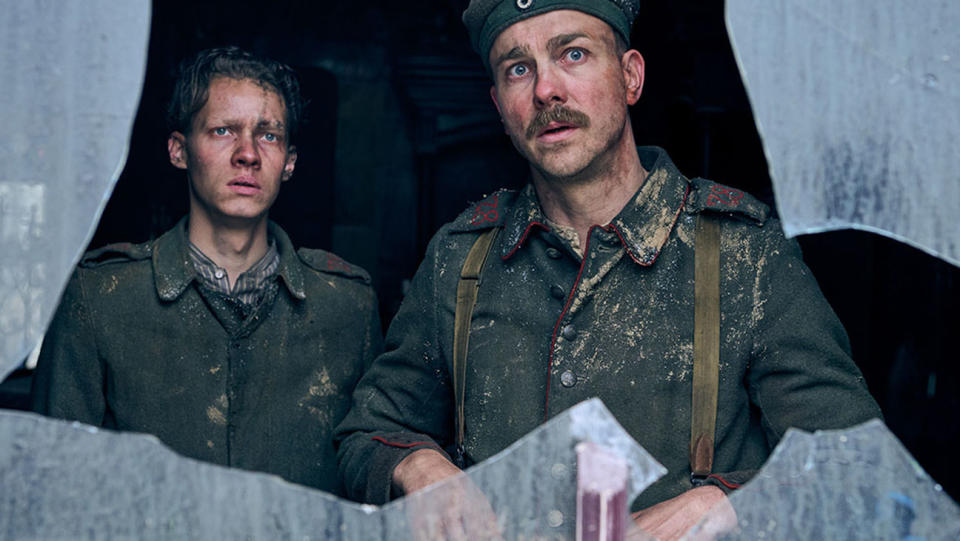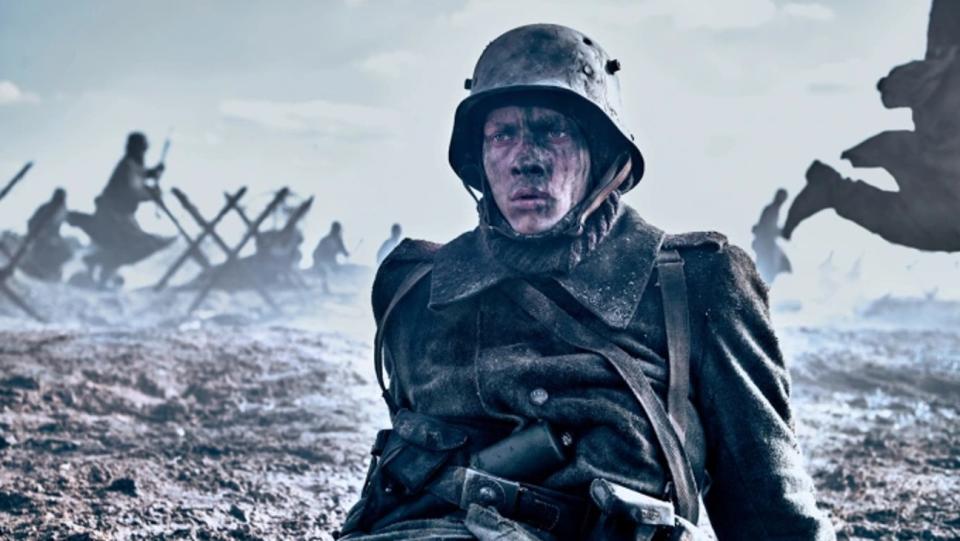Oscars: The Hidden Craft of ‘All Quiet on the Western Front’
- Oops!Something went wrong.Please try again later.
- Oops!Something went wrong.Please try again later.
- Oops!Something went wrong.Please try again later.
- Oops!Something went wrong.Please try again later.

Whatever happens at the 2023 Oscars on Sunday, Germany’s All Quiet on the Western Front has already made awards history. Edward Berger’s World War I drama, the first German adaptation of Erich Maria Remarque’s German-language anti-war classic — after Lewis Milestone’s double Oscar-winning version in 1930 and an Emmy-award winning TV take in 1979 — goes into this year’s Oscars with nine nominations, including for best film. That’s the second-highest tally ever for a non-English-language film, just behind the 10 garnered by Ang Lee’s wuxia classic Crouching Tiger, Hidden Dragon and by Alfonso Cuarón’s black-and-white Mexican drama Roma.
The accomplishment is all the more impressive given Berger’s relative anonymity in Hollywood. Lee and Cuarón were already established studio directors by the time of their local-language Oscar triumphs. By contrast, Berger has paid his dues in TV. After cutting his teeth on German procedurals and making a well-received feature debut (2014’s Jack), Berger shifted to high-end series, directing a string of acclaimed dramas, including Deutschland 83, Patrick Melrose and Your Honor.
More from The Hollywood Reporter
THR's 'Behind the Screen' Takes Final Look at the Oscar Crafts Categories
Pedro Pascal, Kate Hudson, Harrison Ford Added to List of 2023 Oscars Presenters
All Quiet on the Western Front was a slow awards-season starter. The Netflix film had a relatively soft launch in Toronto last year where it received strong reviews but little buzz. It was only after Netflix dropped All Quiet on its platform in late October and more people began to see the movie — helped by Netflix’s all-out awards push — that the momentum began to build, rising to a crescendo with a record-setting 14 BAFTA nominations (the film won seven, including best film and best director) and nine Oscar nods.
Much of the credit for All Quiet‘s come-from-nowhere awards success has to go the film’s behind-the-camera talent. The craft nominations — for best makeup and hairstyling, best music, best sound, best visual effects, best cinematography, best production design — speak to peer recognition from within the Academy.
“The Best Picture nomination obviously, is fantastic, because that’s mine,” says All Quiet on the Western Front producer Malte Grunert, “but I’m extremely happy and proud about the recognition that all the heads of departments and all the crafts are getting. Because there were so many fantastic people working on this film that gave it their very best. To see them recognized is really beautiful.”

Berger and All Quiet cinematography James Friend eschewed the visual gimmickry of war epics like Sam Mendes’ 1917, with its digitally constructed “one shot” concept, or Christopher Nolan’s Dunkirk, with its separate color and sound palates for battles on land, sea and air, in favor of a more classic and realistic approach. From the costumes to the makeup, from visual effects to sound design, the goal was to be as realistic as possible and underscore the movie’s anti-war and deliberately unheroic depiction of an ordinary soldier in battle.
“We didn’t want to create another grand spectacle of a war movie, especially when it came to the visual effects,” says Frank Petzold, head of All Quiet‘s VFX team. ” Now that’s hard to do. Because what you learn all your life, when you do this craft is, especially on war films, you usually want bigger, louder, more and more, but here the goal was the opposite: to be invisible to the audience. We knew it was going to be a lot of work. And, on top of it all, it had to be absolutely historically correct. It had to be fully real to the point where nothing would distract from the actors, because there are such long takes on the actors’ faces.”
Staying away from “crazy technology” as much as possible, Petzold and his team focused on in-camera effects for the bulk of VFX shots in the film.
“Of course, we had to use computer simulations for certain things, like fog rolling over the battlefield, but all the explosions, the dirt kicking up, all that stuff, we wanted to keep that real,” he says, “so we actually went through the trouble, which is a lot more work, of doing it all set. Even silly things, like there’s a shot in the film with the camera looking down the barrel of a tank when it fires. That shot is maybe seven or eight frames. Usually you’d go to one of those Houdini computer guys and ask them to knock something out. We actually went on a stage and built steel pipes, stuffed them full of black powder so we could film the real explosion. Even if we had a separate piece we shot on a greenscreen in the field, we’d do the effect in camera so it could be laid in later.”

And that scene late in the movie, where in a French bunker, hundreds of rats suddenly run out, feeling the incoming attack? Real rodents.
“Everybody has a 3D rat model somewhere on their hard drive,” says Petzold, “but the philosophy was always: make it real. There are a lot of little things but they add up. If you notice, the cutting pace in this film is quite slow. It’s almost like a spaghetti western, we spend a lot of time looking at individual shots. So for the VFX people, it was great, because people can actually look at our stuff, see all those little details.”
A visual touchstone for the All Quiet team was Peter Jackson’s They Shall Not Grow Old, a 2018 documentary film created using original WWI footage from the archives of the Imperial War Museum that Jackson painstakingly restored and colorized, using photography and original references from the period.
“I’d never done a war movie before and I didn’t know the period [WWI] at all, so the documentary basically changed a lot for me,” says All Quiet makeup and hairstyle artist Heike Merker. “I took so many screenshots from it and shared those pictures with our different departments. One of the first things everyone said was: ‘Oh my god, their teeth are so bad, we have to do something with that.'”
Every actor playing a soldier got a dentist appointment, where they got imprints of their teeth. Using so-called “invisible line” dentures, which she painted in tones of yellow and brown, Merker was able to re-create a time before modern dentistry.
An admitted obsessive, Merker mixed dozens of different types of mud for the trench and battle scenes — mud after a rainfall, mud that had dried out and began to cake, old mud layered on new mud. The “death mask” of half-caked gray mud on lead Felix Kammerer’s face near the end of the movie — in the scene where his character brutally murderers a French soldier in a bomb crater — was the result of hours of layering.
“We used several different products to build up the mask and then food coloring on that, which we had to re-apply, re-apply, re-apply, after every take, often spraying it to keep the mask moist so it didn’t crack and fall off,” she says.
Merker spent hours more on the blood.
“When it comes to blood, I always have the sense watching movies that the blood used is too thick and the color is not right. It never looks like blood does when I cut my finger in the kitchen,” she says, “so we made our own blood, of different consistencies and different colors. But it is used sparingly. The film doesn’t really live from its gore or violence. When we have moments of violence, they are very short and precise. The editing is done so that those moments are brief. You barely see anything, but the impact is there.”
Whatever the Academy decides Sunday, the impact of All Quiet on the Western Front is undeniable. Not least from the film professionals who endured the shoot.
“It was a really tough shoot,” says Petzold. “Behind the camera looked the same as what you see on the screen. We’d be there at three in the morning, in the snow and the mud, getting the shots. For a German film it was a big budget, thanks to Netflix for that, but I’ve worked on big U.S. features and compared to those it was very small. But it’s like Roger Corman said: the smaller the budget, the more they leave you alone. We had incredible freedom on set, we worked very closely with Edward [Berger] and the DOP, discussion shots, even ones we weren’t involved in. It was an incredible team effort. So, for the Oscars, just to be nominated is an incredible reward.”

